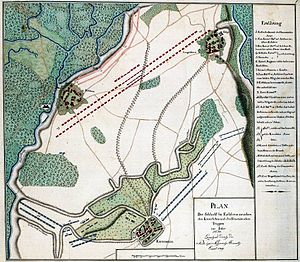Battle of Enzheim
| date | October 4, 1674 |
|---|---|
| place | Entzheim |
| output | draw |
| Parties to the conflict | |
|---|---|
| Commander | |
| Troop strength | |
| 27 battalions of infantry (= 17,000 men), 123 squadrons of cavalry (= 15,000 men), 50 guns | 20 battalions of infantry (= 12,000 men), 85 squadrons of cavalry (= 10,000 men), 20 guns |
| losses | |
|
4000 men |
2500 men |
Dutch War (1672–1678 / 79)
Solebay - First Schooneveld - Second Schooneveld - Texel - Bonn - Maastricht - Sinsheim - Seneffe - Enzheim - Türkheim - Sasbach - Konzer Bridge - Stromboli - Augusta - Palermo - Kokersberg - Philippsburg - Maastricht - Valenciennes - Tobago - Cassel - Freiburg - Ypres - Rheinfelden - Saint-Denis
The Battle of Enzheim (partly also Entzheim , Holzheim ) took place on October 4, 1674 between French troops on the one hand and imperial and imperial troops on the other during the Dutch War near Entzheim in Alsace . Despite the numerical superiority of the imperial family, it ended in a draw.
prehistory
The imperial troops under Alexander de Bournonville had managed to cross the Rhine with the help of the population of Strasbourg and advance into Alsace. They gathered between the Rhine and the Vosges . The goal was to deny the French access to Upper Alsace. The French commander Henri de La Tour d'Auvergne, vicomte de Turenne wanted to prevent this. This was also about not allowing a union of the imperial troops with the Brandenburg army, which stood near Heilbronn . Although his army was clearly weaker, Turenne let them advance in forced marches against the enemy. The allies, on the other hand, had only advanced slowly and had not yet occupied the crossings over the Breusch .
course
The battle broke out near Entzheim, about 10 kilometers southwest of Strasbourg. The imperial troops took up a position protected by trenches and hedges between the Breusch and the Ill . There were forests in front of the front, but they were not initially occupied. On the morning of October 4th, French troops attacked. They occupied the forest on the left wing of the imperial family before they also took this step. The grove was held by the French.
Bournonville ordered a cavalry attack on the right wing. This failed. After a long battle, both armies were exhausted. Turenne had succeeded in repelling all attacks of the imperial, but saw himself not in a position to attack the central position of the enemy. The battle therefore ended at 2 a.m. on the French right wing and at 4 a.m. on the left wing. Only artillery battles were fought until dark. During the night both armies withdrew. Only a few French squadrons of cavalry remained on the battlefield.
consequences
The battle had no immediate effect. The imperial commander acted without much skill as Turenne's fame grew. Mistrust and disagreement increased among the allies.
literature
- Hermann Pastenaci: The battle of Enzheim on October 4th 1674 Halle 1880, (Halle-Wittenberg, University, dissertation, 1880; digitized version ).
- Gaston Bodart (ed.): Military-historical war lexicon. (1618-1905). Stern, Vienna 1908, p. 95 .
- Georg von Alten (Hrsg.): Handbook for Army and Fleet. Encyclopedia of Martial Sciences and Allied Fields. Volume 3: Steamship - FZM. Bong & Co., Berlin et al. 1911 p. 397, ( digitized version ).
- Gerhard Taddey (ed.): Lexicon of German history . People, events, institutions. From the turn of the times to the end of the 2nd World War. 2nd, revised edition. Kröner, Stuttgart 1983, ISBN 3-520-80002-0 , p. 324.
